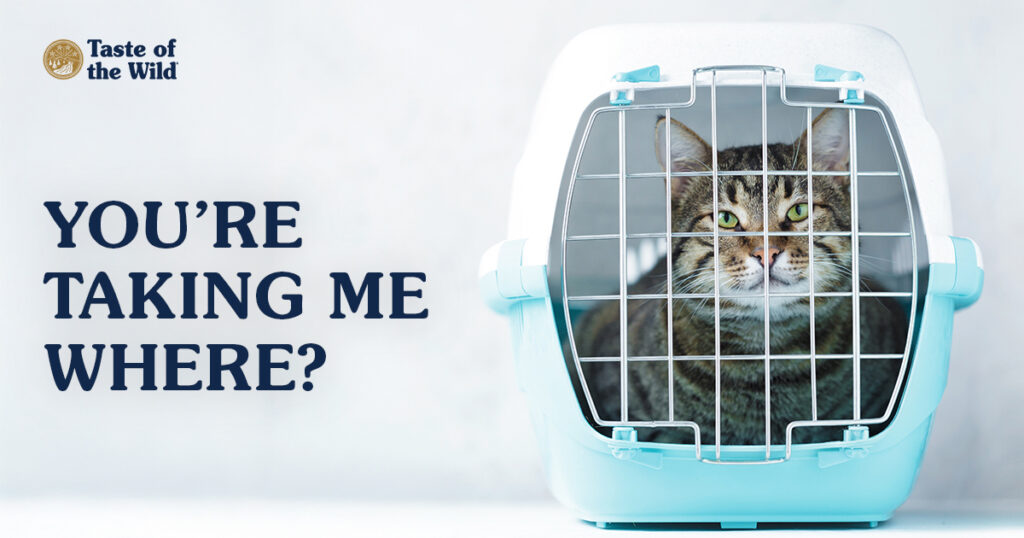
“White coat syndrome” is a very real phenomenon. For people who suffer from this disorder, the mere sight of a doctor — usually clad in a white lab coat — is enough to send their blood pressure skyrocketing. A similar thing can happen to cats (and dogs), too. The stress of a trip to the veterinarian can lead to caterwauling during the car ride and the uncanny ability to brace their paws inside the carrier, defying extrication.
The result of these fears? Some pet parents feel bad for their cats and avoid taking them for annual checkups or don’t stick to the vaccination schedules advised by their veterinarian. These anxious cats may potentially miss out on an early diagnosis of an underlying medical condition if they do not have regular checkups. That’s why we’re sharing tips to help make vet visits less stressful for you and your cat.
Signs My Cat Has Anxiety
General signs of anxiety in cats usually involve changes in their behavior as well as physical symptoms. Common cat anxiety symptoms include refusing to eat, excessive grooming, becoming more reclusive and litter box issues. Other physical signs of an anxious cat include their hair standing on end, dilated pupils, cowering, ears flattened and head lowered, and holding their tail low and tight against their body. A change in a cat’s behavior can also be due to a health condition, so contact your veterinarian if you notice behavioral changes.
Temporary Cat Anxiety Treatment
If your cat’s appointment is within the next few days, and they have shown signs of severe anxiety during previous visits, ask your veterinarian for advice and if sedative medication is appropriate for your cat. The medication can be given to your cat a few hours before the appointment. There are also calming products such as pheromone sprays for feline anxiety on the market, but check with your veterinarian to make sure they won’t react negatively with any of your cat’s underlying health issues. Or you can consider working with a veterinarian who does house calls.
When it comes time for your cat’s actual appointment, find out if your clinic has “cat-only” examination rooms. Some clinics spray cat-friendly pheromones in rooms, and the staff know stress-free handling techniques to ease cat stress during wellness exams, vaccinations and other consultation visits. Depending on your cat’s medical condition and required treatments, your veterinarian may be able to follow up with you over the phone or by video conference instead of scheduling more appointments.
How to Calm a Cat Down for Their Next Checkup
As they say, “Prevention is better than cure,” so for a more long-term solution to your cat’s veterinary visit anxiety, the time to start taking action is weeks before their next appointment. The first step is controlled exposure to the dreaded cat carrier. There’s a good chance that the sight of the carrier is a trigger for anxious behaviors and a cue for your cat to bolt under the bed — especially if your cat only associates traumatic events with it, such as trips to the veterinarian or the groomer. But you can help change that emotional response by separating the carrier from stressful situations. And by exposing kittens to positive associations with the carrier at an early age, you can avoid difficult situations when they’re adults.
You do want to use a carrier: It’s safer for you and your cat for the trip to and from the clinic. The carrier should be large enough to allow your cat to stand up and turn around inside. Ideally, the carrier should have a removable top, whether it’s a hard-plastic model that can be unscrewed or a soft-sided carrier with a zipper at the top.
Make the Cat Carrier Hard to Resist
About a month before your appointment, start associating all things positive with the carrier.
Remove or open the top and place your cat’s favorite blanket inside, or an article of clothing that carries your scent. Cat pheromones, which can make cats feel calmer, are another option for spraying on the blanket. Then place the lower portion of the carrier in a room the cat frequents and leave it there, so the cat can explore it at their leisure.
Scatter treats, catnip or toys in the carrier to make the cat’s space even more enticing. You can also start to feed your cat outside the carrier and gradually, over the course of a few days, move the food bowl inside.
After your cat is comfortable being in the bottom part of the carrier, add the top, or zip the top closed, but leave the door open, so your cat can come and go. Once your cat is comfortable with that, try closing the door for short periods of time and dropping high-value treats inside so your cat associates awesome things with the carrier. Hopefully, over time the carrier becomes a normal part of your cat’s life.
Help Your Anxious Cat Become Accustomed to the Car
Now that time in the carrier with the door closed doesn’t trigger anxiety for your cat, pick up the crate and carry it a few feet, so your cat gets used to that feeling. Gradually increase the distance until you can place the carrier in the car.
Secure the carrier with a seat belt so it doesn’t slide around. Drop a few treats in the carrier and start the car, let it idle for a short period, then stop. For some cats, it helps to drape a light blanket or towel over the carrier, so they aren’t scared by unfamiliar sights. The next day, take a trial drive around the block and gradually increase the length of your drive.
Happy Veterinary Visits Can Help Relieve Cat Stress
From the cat’s view, a fear response to their veterinarian is reasonable: the clinic has a long list of cat anxiety triggers and physical pain if they need blood tests or other diagnostic tests. The clinic could be an environment of loud noises and other cats and pets — unfamiliar experiences that are known to raise anxiety in cats.
So call your veterinary clinic and see if you can schedule a few “happy” visits for your cat. These are five- or ten-minute visits during which clinic staff bring your kitty into an exam room and deliver treats in a calm setting to help your cat adjust to the sights and smells of the clinic and associate positive feelings with it. This is especially helpful if you have a kitten who hasn’t been to the veterinary clinic very often.
With a little help, your cat can learn that a vet visit doesn’t have to be scary. That, of course, can make your life a lot easier, too. And you can feel gratified that you’re providing your cat with the health care that could enhance and even extend their life.



